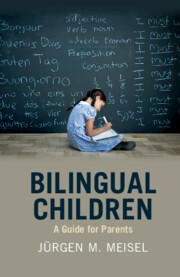Book contents
- Bilingual Children
- Bilingual Children
- Copyright page
- Dedication
- Contents
- Preface
- Abbreviations
- 1 Bilingualism in Early Childhood
- 2 How Infants Become Native Speakers
- 3 Two Languages in One Mind
- 4 Keeping Languages Apart
- 5 Language Dominance
- 6 Trilingual and More
- 7 The Age Question
- 8 Benefits and Advantages of Child Bilingualism
- Bibliography
- Index
- References
5 - Language Dominance
Strong and Weak Languages
Published online by Cambridge University Press: 08 June 2019
- Bilingual Children
- Bilingual Children
- Copyright page
- Dedication
- Contents
- Preface
- Abbreviations
- 1 Bilingualism in Early Childhood
- 2 How Infants Become Native Speakers
- 3 Two Languages in One Mind
- 4 Keeping Languages Apart
- 5 Language Dominance
- 6 Trilingual and More
- 7 The Age Question
- 8 Benefits and Advantages of Child Bilingualism
- Bibliography
- Index
- References
Summary
Some bilingual children stop speaking one of their languages although they understand it. Why do they do this? Will they loose the knowledge they have acquired up to this point? Or will they acquire an incomplete knowledge of this language? Can parents encourage the use of the dispreferred language? It is difficult to identify the reasons for why children behave as receptive rather than active bilinguals. But the learning environment is clearly relevant. If only one person uses one of the languages with the child, receptive bilingualism is a likely result. Amount of exposure to a language is another crucial factor: the dominant language is most likely to be the one preferred by children. Preference of a language can also indicate a more developed competence in this language. If one language develops at a slower rate or if its grammar is not fully acquired, it is considered to be ‘weaker’. However, incomplete acquisition has only been reported to happen in second language learners, not in simultaneous bilinguals.
Keywords
- Type
- Chapter
- Information
- Bilingual ChildrenA Parents' Guide, pp. 123 - 155Publisher: Cambridge University PressPrint publication year: 2019

